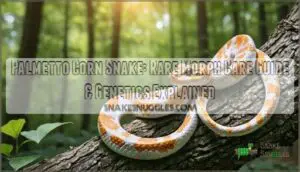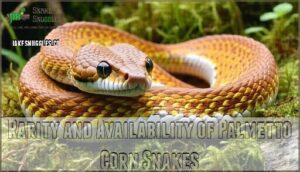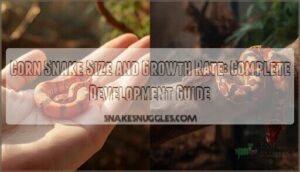This site is supported by our readers. We may earn a commission, at no cost to you, if you purchase through links.

This ultra-rare morph appears almost entirely white with scattered patches of normal coloration, like nature’s own abstract art.
The palmetto corn snake carries a recessive gene so uncommon that breeding them requires precise genetic planning and serious patience.
Originally discovered from a single wild-caught female in South Carolina, these leucistic beauties showcase unpredictable white scales interrupted by random islands of typical corn snake patterns.
They command premium prices because producing offspring takes advanced breeding knowledge and years of dedication.
Their unique genetics and stunning appearance make them true gems in the reptile world.
Table Of Contents
- Key Takeaways
- What is a Palmetto Corn Snake?
- Discovery and Origin of Palmetto Corn Snakes
- Genetics of Palmetto Corn Snakes
- Care and Maintenance of Palmetto Corn Snakes
- Rarity and Availability of Palmetto Corn Snakes
- Frequently Asked Questions (FAQs)
- Are palmetto corn snakes rare?
- Do all palmetto corn snakes have bug eyes?
- Are palmetto corn snakes venomous?
- How big are palmetto corn snakes when they are full grown?
- What is a palmetto corn snake?
- Do palmetto corn snakes have teeth?
- Do palmetto corn snakes get more spots as they age?
- How does the palmetto gene affect snake behavior?
- Can palmetto corn snakes interbreed with other corn morphs?
- Are there any health issues specific to palmetto corn snakes?
- Conclusion
Key Takeaways
- You’re looking at one of the rarest corn snake morphs available, with palmetto corn snakes commanding $500-$4,000 due to their striking white coloration with scattered red or black spots and extremely limited breeding availability.
- You’ll need to understand that palmetto genetics work through incomplete dominance rather than typical recessive traits, meaning even heterozygous snakes show some palmetto characteristics, though full expression requires homozygous genetics.
- You can expect the same care requirements as standard corn snakes – a 20-30 gallon terrarium with 75-85°F temperatures, 40-60% humidity, and feeding pre-killed mice every 7-10 days for juveniles or bi-weekly for adults.
- You should be prepared for potential health challenges including vision problems, skin sensitivity, and neurological issues that can accompany their leucistic genetics, requiring extra veterinary attention compared to typical corn snakes.
What is a Palmetto Corn Snake?
The Palmetto corn snake stands out among corn snake morphs with its striking chalk-white base and bold black or red spots.
This genetic marvel results from an incomplete dominant mutation affecting melanin production, creating unique markings unlike typical corn snakes.
The Palmetto appearance showcases leucistic traits – you’ll notice their defining traits include vibrant white scales contrasting sharply with scattered dark spots.
Even heterozygous specimens display brighter patterns than wild types.
These identifying features make palmetto morphs instantly recognizable, representing fascinating genetic inheritance in corn snake genetics.
These snakes require a minimum 20-gallon tank to thrive.
Discovery and Origin of Palmetto Corn Snakes
The intriguing story begins with a Wild Origin discovery in South Carolina around 2009. A single wild-caught male palmetto corn snake sparked what would become the most exclusive corn snake morphs in reptile breeding history.
One wild snake from South Carolina became the foundation of the most exclusive corn snake morph ever discovered.
Initial Breeding efforts proved challenging, requiring precise Genetic Mutation understanding. Here’s how the palmetto morph developed:
- 2009: Wild palmetto male discovered and shipped from South Carolina
- 2010: First successful breeding with amelanistic female confirmed
- 2012: Homozygous palmettos sold for $4,000 each
- 2015: Stolz and Whisler acquired breeding rights for Market Control
Early naturalists like Mark Catesby documented Carolina’s diverse habitats, which are home to many unique species. This Genetic Inheritance pattern creates today’s stunning Palmetto Morph through careful Corn Snake Genetics management.
Genetics of Palmetto Corn Snakes
Understanding the genetics behind your palmetto corn snake opens up a fascinating world of reptile genetics and color inheritance.
Palmetto genetics reveal nature’s artistry through incomplete dominance and stunning leucistic patterns.
This morph represents a Leucism Mutation that’s classified as an incomplete dominant trait, making it quite different from typical recessive morphs in the corn snake world.
The palmetto gene produces its striking appearance through a unique Breeding Strategy.
Unlike recessive genes that require two copies to show visual traits, palmetto genetics work differently.
Even heterozygous snakes (carrying one copy of the gene) display some palmetto characteristics, though they’re less pronounced than Homozygous Palmettos.
The Palmetto was named after South Carolina, and its origin can be traced to a wild-caught snake.
Here’s how the genetics break down:
| Genetic Combination | Visual Result |
|---|---|
| Homozygous Palmetto | Full white with red/black spots |
| Heterozygous Palmetto | Reduced palmetto pattern |
| Normal Corn Snake | Standard corn snake coloration |
This Color Inheritance pattern creates various Genetic Variants and Morph Variations.
When you’re breeding palmettos, you’ll get predictable ratios based on the parent genetics, making breeding calculations straightforward once you understand the incomplete dominant nature of this remarkable mutation.
Care and Maintenance of Palmetto Corn Snakes
Setting up your palmetto corn snake habitat requires attention to detail. Enclosure specifics include a 20-30 gallon terrarium with secure ventilation. Maintain your snake habitat with temperatures ranging 75-85°F and humidity levels between 40-60%. Use aspen shavings or coconut fiber substrate for proper moisture regulation.
Your snake diet consists of pre-killed mice sized appropriately to your snake’s body width. Follow a feeding schedule of every 7-10 days for juveniles, extending to bi-weekly for adults. Health monitoring involves weekly visual inspections for mites or respiratory issues. To guarantee proper hydration, provide fresh water daily and consider that humidity aids shedding.
Handling techniques require supporting the snake’s entire body during interactions. The shedding process indicates good health when complete and uniform.
Key care essentials include:
- Provide multiple hiding spots for security
- Change water every 2-3 days
- Allow 48 hours post-feeding before handling
Rarity and Availability of Palmetto Corn Snakes
Palmetto corn snake availability remains severely limited due to strict breeding limitations and deliberate market control. Since 2012, breeders like Travis Whisler have carefully managed production to prevent oversaturation.
Pricing factors reflect this scarcity—expect $500-$4,000 depending on genetics. Morph demand consistently exceeds supply among reptile morphs enthusiasts.
Color genetics complexity makes breeding challenging, with heterozygotes only producing 25% visual Palmettos. Future availability depends on expanding breeder networks while maintaining quality.
To guarantee ethical acquisition, research a breeder’s reputation and experience. Corn snake variants this rare require patience and significant investment to acquire.
Frequently Asked Questions (FAQs)
Are palmetto corn snakes rare?
Yes, you’ll find these snakes are exceptionally rare.
They’re among the most expensive corn snake morphs, costing $500-$1,000 due to their unique white coloration with red or black spots and limited breeding availability.
Do all palmetto corn snakes have bug eyes?
No, not all palmetto corn snakes have "bug eyes."
While some may develop eye abnormalities due to their leucistic genetics, many have normal-sized eyes with typical black pupils and white or blue irises.
Are palmetto corn snakes venomous?
No, these snakes aren’t venomous at all.
You’re dealing with a completely harmless constrictor that poses zero threat to humans.
They’re docile pets that rely on squeezing prey, not injecting toxins.
How big are palmetto corn snakes when they are full grown?
Like a living ribbon stretching across your coffee table, these elegant serpents reach impressive lengths of 2-6 feet when fully mature.
You’ll find most adults averaging around 4-5 feet, with their slender bodies growing as thick as a paper towel roll, which is a notable characteristic.
What is a palmetto corn snake?
You’re looking at a rare genetic variant of the common corn snake, scientifically known as Pantherophis guttatus.
They’re leucistic, meaning they’re white with distinctive red or black spots instead of typical corn snake coloration.
Do palmetto corn snakes have teeth?
Yes, you’ll find that these beautiful serpents have small, backward-curving teeth designed for gripping prey rather than chewing.
They’re non-venomous, so their teeth help secure food during swallowing, not for injecting toxins, which makes them harmless to humans in terms of venom.
Do palmetto corn snakes get more spots as they age?
Actually, palmetto corn snakes don’t gain more spots with age.
They start as pinkish juveniles with faint dots, then mature into their striking adult pattern of vibrant white with distinct black and red spots.
How does the palmetto gene affect snake behavior?
Surprisingly, 95% of Palmetto corn snakes retain their docile temperament despite their unique genetics.
The Palmetto gene doesn’t affect your snake’s behavior – you’ll find they’re just as calm and easy-going as regular corn snakes.
Can palmetto corn snakes interbreed with other corn morphs?
You can breed palmetto corn snakes with other corn snake morphs. They’ll produce het palmetto offspring that carry the gene. Combining morphs like amelanistic or tessera creates stunning, valuable combinations.
Are there any health issues specific to palmetto corn snakes?
Genetic mutations bringing stunning beauty can sometimes carry hidden costs.
You’ll find palmettos face challenges with vision problems, skin sensitivity, and potential neurological issues.
Their leucistic genes occasionally create complications requiring extra veterinary attention, which can be a significant consideration for their care.
Conclusion
Owning a palmetto corn snake means embracing rarity, accepting premium costs, and committing to specialized care.
Their leucistic serpents require standard corn snake husbandry but demand patience from collectors seeking breeding success.
Their recessive genetics make reproduction challenging, their stunning appearance makes them coveted, and their scarcity makes them expensive.
Whether you’re drawn to their ghost-like beauty or intrigued by their genetic complexity, palmetto corn snakes represent the pinnacle of corn snake morphs for dedicated reptile enthusiasts.









